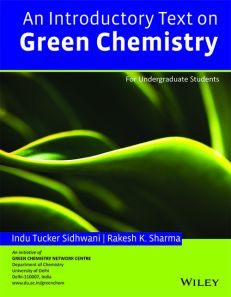An Introductory Text on Green Chemistry: For Undergraduate Students
ISBN: 9788126554072
268 pages
For more information write to us at: acadmktg@wiley.com

Description
Green Chemistry also known as “Clean Chemistry” or “Sustainable Chemistry”, has emerged as an important tool for meeting the major challenges of global sustainability. Innovations and applications of green chemistry in education have helped companies not only benefit environmentally but at the same time achieve economic and societal goals also. As education is the forerunner of implementation, a student must be trained to apply chemistry in a greener way. An Introductory Text on Green Chemistry is designed as a textbook for Discipline Specific Elective Course (DSE) on the subject. This book is written with an objective to introduce the concept of Green Chemistry to undergraduate students.
Chapter 1 Introduction to Green Chemistry
1.1 History Prior to Emergence of Green Chemistry
1.2 Chemical Industries and Pollutants
1.3 Environmental Movements for Public Awareness
1.4 Environmental Laws
1.5 What is Green Chemistry?
1.6 Green Chemistry Advances Towards a Sustainable Future
1.7 Conclusion
Chapter 2 Twelve Principles of Green Chemistry
2.1 Introduction
2.2 Principle 1: Prevention of Waste
2.3 Principle 2: Atom Economy
2.4 Principle 3: Designing Less Hazardous Chemical Synthesis
2.5 Principle 4: Designing Safer Products
2.6 Principle 5: Safer Solvents and Auxiliaries
2.7 Principle 6: Design for Energy Efficiency
2.8 Principle 7: Renewable Resources
2.9 Principle 8: Reduce Derivative
2.10 Principle 9: Use of Selective Catalyst
2.11 Principle 10: Design for Degradation
2.12 Principle 11: You Cannot Control What You Cannot Measure
2.13 Principle 12: Inherently Safer Chemistry for Accident Prevention
2.14 Conclusions
Chapter 3 Emerging Green Solvents
3.1 Introduction
3.2 Defining Green Solvents
3.3 Different Types of Green Solvents and their Role in Diverse Organic Transformations
3.4 Switchable Solvent System
3.5 Conclusion
Chapter 4 Green Chemistry and Catalysis
4.1 Introduction
4.2 Examples of Heterogeneous Catalyst for Better Environment
4.3 Nanocatalyst as Green Solution
4.4 Chlorine Removal from Wastewater
4.5 Emerging Trends in Green Catalysis
4.6 Endangered Elements of the Periodic Table
4.7 Conclusion
Chapter 5 Alternative Green Energy Sources and Sustainability
5.1 Introduction
5.2 Microwave Chemistry
5.3 Sonochemistry
5.4 Light-Induced Photochemical Reactions
5.5 Green Energy and Sustainability
5.6 Conclusion
Chapter 6 Some Important Green Syntheses
6.1 Introduction
6.2 Synthesis of Various Compounds of Importance
6.3 Microwave-Assisted Reactions in Water
6.4 Microwave-Assisted Reactions in Organic Solvents
6.5 Microwave-Assisted Solvent-Free Reaction
6.6 Sonochemical Reactions
6.7 Conclusions
Chapter 7 Green Methodology in Pharmaceutical Industry
7.1 Introduction
7.2 Emergence of Green Pharmaceutical Industry
7.3 Some Problems Faced by Pharmaceutical Industry
7.4 Green Chemistry Solutions to Pharmaceutical Industry
7.5 Green Metrics Used in the Pharmaceutical Industry
7.6 Greening of Pharmaceutical Industry
7.7 Conclusion
Chapter 8 Real-World Cases in Green Chemistry
8.1 Introduction
8.2 Green Chemistry Challenge Awards 2019
8.3 Designing Greener Chemicals Award 2018:
8.4 Academic Award 2017:
8.5 Greener Reaction Conditions Award 2016:
8.6 Designing Greener Chemicals Award 1996: Did you know?
8.7 Academic Award 1997: Did you know?
8.8 Greener Reaction Conditions Award 2002: Did you know?
8.9 Designing Green Chemicals Award 2003: Did you know?
8.10 Designing Greener Chemicals Award 2004: Did you know?
8.11 Greener Synthetic Pathways Award 2005: Did you know?
8.12 Conclusions
Chapter 9 Some Future Trends in Green Chemistry
9.1 Introduction
9.2 Oxidation Reagents and Catalysts
9.3 Biomimetic Chemistry: Multifunctional Reagent
9.4 Combinatorial Green Chemistry
9.5 Proliferation of Solvent-less Reactions
9.6 Non-Covalent Derivatization
9.7 Conclusion
Chapter 10 Green Chemistry in Education (To Meet the Challenges of Sustainable Development)
10.1 Chemistry Practices in India
10.2 Incorporation of Green Chemistry in the Curriculum
10.3 Green Chemistry Network Centre
10.4 Status of GC at Undergraduate Level in India
10.5 Major Websites and Journals of GC
10.6 GC in the Curriculum: Learning Benefits
10.7 Career Prospects
10.8 Conclusion
Did you know?
Questions
References

